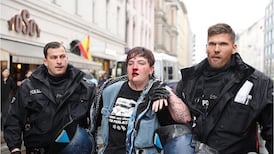Germany's thriving pre-war Jewish community as captured on black and white photographs went on display in Berlin's Jewish Museum today with an exhibit of 90 stirring images by photographer Roman Vishniac.
The portraits of lively street scenes, artists and intellectuals in Berlin taken just before the Holocaust recall a vibrant Jewish culture in the German capital.
The previously unpublished pictures were only found after Visniac died in 1990. Jewish culture flourished in Berlin before the Nazis took power - it was one of the world's 10 largest Jewish centres and many of Germany's top scientists, such as Albert Einstein, were Berlin Jews.
There were about 160,000 Jews in Berlin in 1933, but only 1,400 in 1945. "These photos show a city where everyone was involved in culture, art, politics and philosophy," said Sarah Kushinsky (25) whose grandfather was taken to a concentration camp but survived and later emigrated to Australia.
"They show the Jewish culture at its peak before the crash," said Ms Kushinsky, who is a student in Switzerland and went to the exhibit's opening today with her grandfather.
"I don't think there will ever be anywhere like Berlin was then again." Vishniac, known for his pictures of pre-war Jewish life in Eastern Europe, was a Russian-born Jew who went to the United States. He was a biologist, linguist, art historian and philosopher as well as a photographer.
His pictures of Jewish communities of Eastern Europe taken on the eve of World War Two are included in his most famous collection of pictures called "Vanished World".
David Prince, who survived Auschwitz and emigrated to Melbourne, said he was delighted by the exhibit. "Germany was recognised as the most cultural country at the time, and suddenly turned into the horror of mankind," said Prince, 80.
"We take great pride though in the knowledge that the cultural wealth shown in these photos is part of Jewish history, and that we survived and continued tradition." "My favourite photo is the one of workers breaking into an impromptu Jewish dance in a work camp in the Netherlands," said Alana Honigman, a 20-year-old student from the United States. Her father had lost most of his family in the Holocaust.
Germany now has the world's fastest-growing Jewish population. Though still a fraction of the half-million strong community when the Nazis came to power in 1933, it has more than doubled in a decade to about 100,000 with immigration from the former Soviet Union and eastern Europe.
Despite Germany's history as the nation that carried out with grisly efficiency the murder of some six million European Jews, thousands of Jews have elected to emigrate to Germany because they want to stay in Europe.







